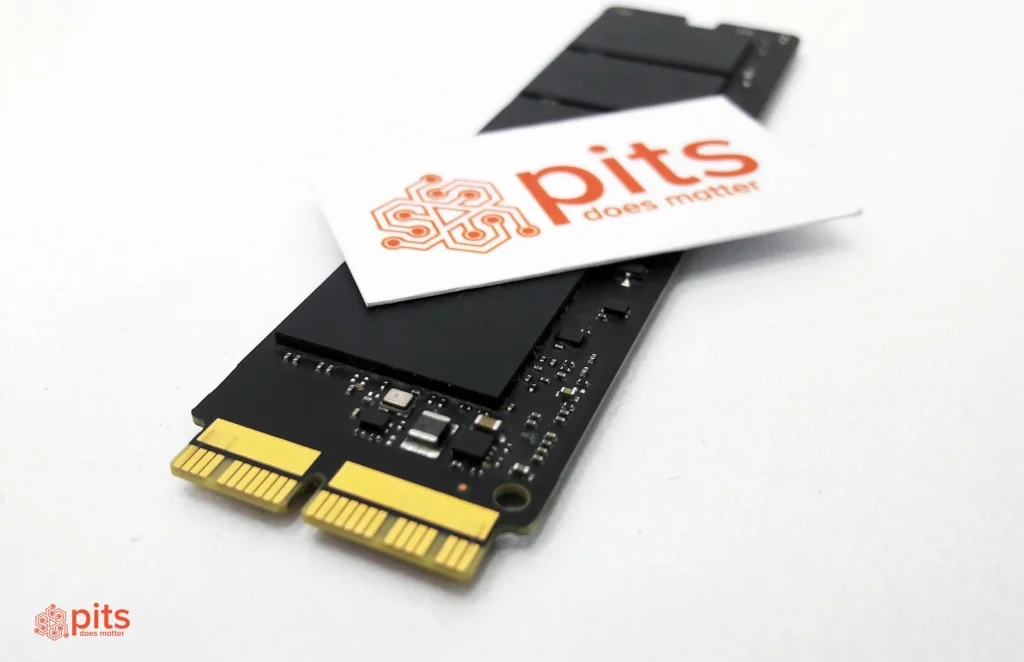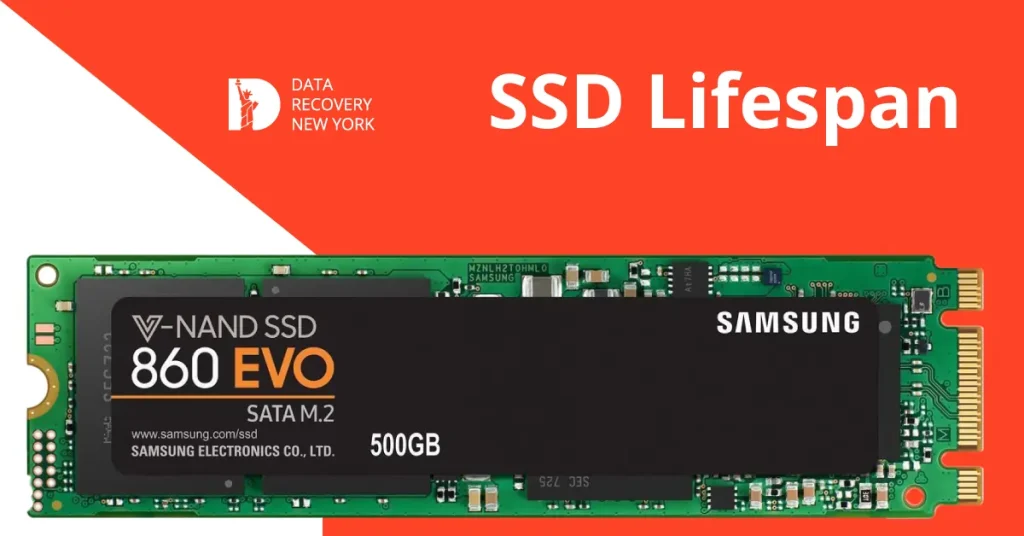A Solid-State Drive (SSD) is a fantastic data storage device that uses NAND-based flash memory to store and retrieve data. Unlike traditional Hard Disk Drives (HDDs) that use spinning disks and mechanical components, SSDs have no moving parts. This awesome design offers numerous advantages, including super-rapid data entrance speeds, lower power consumption, and enhanced resilience.
Plus, the absence of mechanical components means SSDs are tough cookies that can handle physical shocks, making them reliable. SSDs have become popular in modern computing devices, delivering good performance and efficiency compared to old-school storage solutions.
SSD Lifespan - Basics
SSD lifespan refers to a solid-state drive’s expected time to function and control its performance reliably. Compared to traditional HDDs, which use mechanical components and spinning disks, SSDs rely on NAND-based flash memory, which has limited program/erase (P/E) cycles. Now let’s dive into some details:
NAND Flash Memory and P/E Cycles:
SSDs store data in NAND flash memory cells. Each cell has a limited number of P/E cycles, referring to the process of programming (writing) and erasing data. Over time, as data is written and erased, the individual cells wear out.
Wear Leveling:
Wear leveling algorithms are employed to extend the SSD lifespan. These algorithms evenly distribute “write” and “erase” cycles across all memory cells, preventing certain cells from wearing out faster than others.
Types of NAND Flash:
The type of NAND flash used in an SSD impacts its lifespan. Single-Level Cell (SLC) NAND offers higher endurance but is costlier. Multi-Level Cell (MLC) and Triple-Level Cell (TLC) NAND are more common, with varying endurance levels.
TBW (Terabytes Written) and DWPD (Drive Writes Per Day):
Manufacturers often specify an SSD’s endurance in terms of Terabytes Written (TBW) or Drive Writes Per Day (DWPD). TBW indicates the total amount of data resources that can be written to the drive disc over its lifespan, while DWPD specifies the average daily amount of data that can be written.
Understanding the SSD lifespan is crucial for users to manage expectations, implement proper usage practices, and choose the right SSD for their needs, balancing factors like performance, cost, and longevity.
SSD Lifespan - Which Factors Affect
Too many factors can influence the lifespan of an SSD. Understanding these issues is important for users to maximize the longevity and performance of their SSDs. Here are key factors that can affect SSD lifespan:
Over-Provisioning:
The extra capacity beyond the advertised storage helps wear leveling, bad block management, and overall performance optimization, impacting the SSD lifespan.
Temperature and Operating Conditions:
Operating the SSD within specified temperature ranges is crucial. High temperatures may accelerate the degradation of NAND flash memory, affecting both performance and lifespan.
Quality of the Controller:
The controller’s quality directly influences data transfer, wear leveling, and overall SSD performance. A high-quality controller contributes to better endurance.
Write Amplification:
Minimizing write amplification, where unnecessary data is written, helps preserve the SSD’s lifespan by reducing the overall number of write cycles.
Usage Patterns:
Continuous, heavy write operations, such as constant downloading or use of write-intensive applications, can impact the SSD lifespan based on its endurance specifications.
Considering these factors allows users to make informed decisions, implement best practices, and choose SSDs that align with their specific usage scenarios while maximizing the lifespan of their storage devices. Otherwise, you may face unforeseen data loss. In such cases, seek assistance from data recovery services, such as PITS Global.
Is SSD Life Expectancy Predictable?
The life expectancy of an SSD drive or SSD lifespan is primarily determined by its endurance, measured in terabytes written (TBW). Standard consumer-grade SSDs typically have a TBW rating that ranges from 60 to 600 terabytes, while high-endurance enterprise-grade SSDs can exceed 10,000 terabytes.
A consumer SSD can last several years with average usage patterns before reaching its TBW limit. However, advancements in SSD technology, wear leveling algorithms and over-provisioning continue to extend the overall lifespan of SSDs, making them durable and reliable storage solutions for a broad range of applications.

How long does an SSD last?
The lifespan of an SSD varies based on factors such as usage patterns, the type of NAND flash memory, and the manufacturer’s specifications. Standard consumer-grade SSDs typically last for several years, with an average lifespan ranging from 3 to 10 years under normal usage conditions.
Yet, this estimate can be influenced by factors like write-intensive tasks, operating temperatures, and the overall workload placed on the SSD. Advances in SSD technology, wear leveling, and over-provisioning have contributed to longer SSD lifespans, making SSDs dependable storage solutions for both personal and professional use.
How to Calculate SSD Lifespan?
Calculating the lifespan of an SSD involves understanding its endurance, usually specified by the manufacturer in terms of Terabytes Written (TBW). It represents the total amount of data that can be written to the solid-state drive over its lifetime. To estimate the lifespan of your SSD, follow these steps:
Identify TBW Rating:
Check the SSD specifications provided by the manufacturer. Look for the TBW rating, expressed in terabytes.
Determine Average Daily Writes:
Estimate your daily data write activity. This could be creating, modifying, or saving files. For example, if you write 10 GB of data daily, that's 0.01 terabytes.
Calculate SSD Lifespan:
Divide the TBW rating by your average daily writes. It gives you an estimate of how many days the SSD can last under your typical usage. For example:

Convert SSD Lifespan to Years:
If you want the result in years, divide the calculated lifespan in days by 365.25 (considering leap years). For example:

Bear in mind that these calculations provide estimates based on your specified average daily write activity. Factors like temperature, workload variations, and firmware optimizations can influence lifespans. It’s also worth noting that SSDs often continue to function after reaching their TBW limit, but with potentially reduced performance.
How to Optimize SSD Longevity?
To optimize the SSD life expectancy, consider the following tips:
Enable TRIM
Ensure TRIM is activated to facilitate efficient data management.
Firmware Updates
Regularly check and apply firmware updates provided by the SSD manufacturer for potential performance and durability enhancements.
Minimize Write Operations
Reduce unnecessary write operations to minimize "write" amplification and extend the SSD's lifespan.
High-Quality Controller
Choose SSDs with high-quality controllers, as they are crucial in efficient wear leveling.
Temperature Control
Keep the SSD within its specified temperature range to avoid accelerated wear on the NAND flash memory.
Regular Backups
Perform regular backups of important data to ensure recovery during unexpected failures.
Avoid Defragmentation
Unlike HDDs, SSDs do not benefit from defragmentation; modern operating systems handle SSDs appropriately.
Monitoring Tools
Use monitoring tools provided by the SSD manufacturer or third-party applications to track SSD health and performance.
Consider Usage Patterns
When selecting an SSD, consider your usage patterns. Opt for higher TBW ratings for tasks involving heavy write-intensive operations.
By implementing these practices, you can optimize the performance and average SSD lifespan your SSD, ensuring reliable storage for an extended period.
Frequently Asked Questions
What is the basic difference between SSDs and traditional HDDs in terms of design and functionality?
SSDs use NAND flash memory and have no moving parts. They offer benefits like fast data access, low power consumption, and improved resilience compared to traditional HDDs with spinning disks and mechanical components.
What factors impact the lifespan of an SSD, and how do wear leveling algorithms contribute to its longevity?
Factors such as over-provisioning, temperature, controller quality, write amplification, usage patterns, and technological advances impact SSD lifespan. Wear leveling algorithms evenly distribute write and erase cycles across memory cells, preventing premature wear and extending the SSD’s overall lifespan.
How is the lifespan of an SSD measured, and what is the significance of Terabytes Written (TBW)?
An SSD’s lifespan depends on its endurance, measured in Terabytes Written (TBW). Consumer-grade SSDs usually have a TBW rating ranging from 60 to 600 terabytes. TBW reflects the total data that can be written to the SSD, affecting its durability.
What factors should users consider when calculating the lifespan of their SSD?
Users should identify the SSD’s TBW rating, estimate their average daily data write activity, and calculate the estimated lifespan in days and years. Factors like temperature, workload variations, and firmware optimizations can affect the accuracy of these estimates.
How can users optimize the longevity of their SSDs, and why is over-provisioning important?
For optimal SSD longevity, enable TRIM, apply firmware updates, maintain free space, minimize write operations, choose high-quality controller SSDs, and consider usage patterns. Over-provisioning, the extra capacity beyond advertised storage, aids wear leveling, bad block management, and overall performance optimization, improving SSD longevity.

